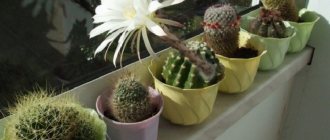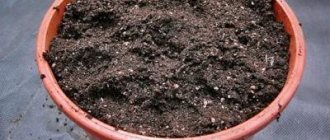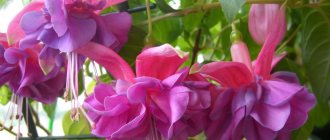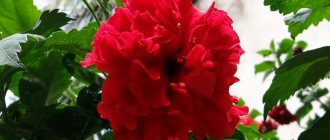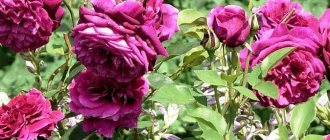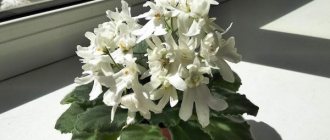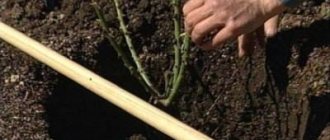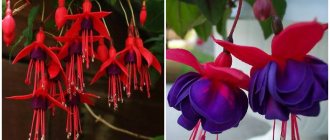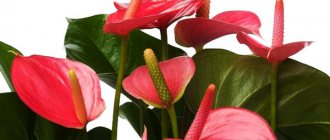Fuchsia (Fuchsia) is a very beautiful plant found on our windows. It belongs to the fireweed family (Onagraceae). There are about 100 species of fuchsia found in the world, but only a few are used as ornamental plants. Fuchsia flowers look like pendants: silky petals are slightly curved upward, a long corolla hangs from the middle of the calyx, trembling at the slightest movement of air.
Nowadays, fuchsia with single-color red flowers is most often found. However, there are fuchsias in which the flower is colored soft pink or white. Multi-colored fuchsia looks very unusual: with a white calyx and a red corolla, or with a red calyx and a dark purple corolla. There is also a fuchsia with double flowers: due to its lush petals, its flowers resemble a ballerina’s tutu.
The closest relatives of fuchsia are the well-known fireweed, evening primrose, or night candle, with bright yellow fragrant flowers.
Botanical description
Fuchsia is a perennial plant, shrub or low tree with small rounded, slightly elongated leaves located on thin flexible branches, a powerful root system and flowers of unusual shape.
Flowering occurs in the summer and can continue until the end of autumn. The main varieties of Fuchsia are shrubs, trees and carpets. Mostly shrubby plant species are grown at home.
Indoor Fuchsia is a relatively small branched shrub with drooping or erect branches.
REFERENCE. Particularly appreciated are those varieties of Fuchsia that can be grown as hanging plants in hanging pots.
Biological certificate
The name of the beautiful plant with bright earrings was given by its discoverer, the Frenchman Charles Plumier. In the name of the flower, the scientist immortalized the name of his German colleague Leonard Fuchs, who lived in the 16th century and was considered one of the “fathers of botany.” According to its systematic position, Fúchsia belongs to the fireweed family.
“Gypsy earrings” or “ballerina”, as fuchsia is affectionately called, is still found growing wild in its homeland - in Central and South America. The selection and cultivation of fuchsia as a houseplant began at the end of the 18th century, when it came to England.
Externally, the plant is a low (from 40 to 90 cm) evergreen shrub with simple or double flowers. They consist of brightly colored reflexed sepals and a shorter tubular corolla with long stamens. The color palette of Japanese lanterns is very rich - from dark purple to white, including all shades of red, lilac and even yellow.
Plant structure
Roots
The plant has a powerful and developed root system. Because of this, it easily tolerates transplantation and propagation.
An important condition for growing is constant access of air to the roots. To do this, you will have to periodically loosen the soil and use light soil.
Leaves
The leaf blades of most plant varieties are oval with a sharp tip. Although there are specimens with ovate and lanceolate leaves.
The color of the leaf blades is green (there are varieties with a reddish tint). The edge may be jagged.
The leaves grow on petioles that have a noticeable reddish tint.
Flowers
Flowers are the main decorative part of the plant. They grow on flower stalks. Depending on the variety - separately or in inflorescences. It is precisely because of the appearance of the flowers, which resemble the silhouette of a woman in a skirt, that Fuchsia is popularly nicknamed “Ballerina”.
The shape and shade of flowers may vary. There are both single-color and two- and three-color specimens.
The flower consists of sepals, petals growing in a tube, and long yellow stamens.
To the touch, the petals can be simple or terry.
INTERESTING. In some countries, Ballerina flowers are used to decorate culinary dishes, mainly desserts and salads.
Fruit
It bears fruit with small dark, slightly elongated berries, similar to chokeberries.
Unlike most other houseplants, Fuchsia fruits are edible. They taste sweet, slightly tart. In countries where Ballerina grows naturally, a variety of tinctures, liqueurs and jams are prepared from its fruits.
Culture propagation
The most commonly used propagation of fuchsia is cuttings and seeds. The last method is more labor-intensive. Seeds are planted in small containers. But there is no need to bury them, but only lay them on top of a moistened soil substrate. Bowls with seeds are placed in a warm and well-lit place. Shoots appear in 12-15 days. Picking is done one and a half months after planting, and after two months the seedlings are transplanted into separate pots.
Autumn and spring are good times for cuttings. The procedure consists of four stages.
- A healthy shoot (up to 10 cm) is taken from the bottom of the main stem.
- The lower leaves are removed from the cuttings.
- The tip of the cutting is placed in water or poured sand.
- After two to three weeks, when small roots appear, the cuttings are planted in pots.
Signs and superstitions associated with Fuchsia
It is no wonder that such an unusual plant as Fuchsia is associated with so many interesting signs and beliefs.
- Fuchsia protects the house from negative external influences.
- The ballerina is the patron saint of creativity and creative professions.
- Gypsy earrings can be safely given to newlyweds and new residents. Fuchsia will help them improve their life in their new home.
- Women who want more male attention need to take a very responsible approach to caring for the Ballerina. The more magnificent the flowering, the more compliments and gifts from the stronger sex.
- The flower has a calming effect on the nervous system, allowing you to collect your thoughts and prepare for making an important decision.
- The plant is believed to help cope with gastrointestinal diseases.
- An unpleasant superstition. Sometimes the plant is called "Widow's Tears". Because of this, it is not recommended to grow it for women whose husbands work in dangerous jobs.
INTERESTING. According to legend, Fuchsia appeared when a wizard bewitched seven sisters who refused to become his concubines.
What is sick?
A healthy plant has leaves that are rich and healthy in color. If fuchsia sheds its leaves, they dry out and become stained - then this is a sure sign of disease. Take a closer look at the plant and it will tell you what the cause of the disease is.
- Powdery spots. A sign of powdery mildew, which appears when there is excess moisture. For disease, the plant is treated with Topaz and Fundazol.
- Dryness and yellowness. If the leaves dry out, this indicates chlorosis. To combat the disease, watering with a manganese solution is used.
- Brown spots. The rusty areas are removed, and then the plant is sprayed with Bordeaux mixture.
Pests cause big trouble. If white fly larvae are annoying, then treatment with the drug “Aktelik” or “Angara” is used. As reviews confirm, these products also help against many other insects that plague fuchsia.
If you know how to care for fuchsia during flowering and follow all the growing rules, your home greenhouse will be decorated with an incredible flower, which is popularly called “gypsy earrings.”
Flower varieties
Fuchsia is loved not only by flower growers, but also by breeders. Over the entire period that the flower has been a cultivated plant, many varieties and hybrids have been bred. Every year more and more specimens appear, differing in the shade and size of the flowers, the shape of the leaves, etc.
In flower shops in our country you can most often find the following varieties:
- Brutus . One of the most popular varieties. It is a small bush. The inner petals of the flowers are purple, and the outer petals are scarlet.
- Deep Purple . A variety with drooping branches and large double flowers of deep purple color.
- Checkerboard . It is distinguished by erect, slightly branched shoots and red and white flowers.
- Bella Rozella . The peculiarity is the iridescent pink hue of the flowers.
- Leonberg . The petals of this variety are pink, but the bracts have a different shade
Floral earrings for everyday wear and evening out
Among the silver items, it is not difficult to find a miniature model that will look harmonious in everyday life. Pay attention to the stud earrings with enamel coating and a scattering of inexpensive jewelry stones - these earrings are ideal for a set of jeans with a stylish pullover, and for any light summer look.
Silver earrings with cubic zirconia and enamel, SL (price on the link)
For a dress with a floral pattern, earrings must be chosen carefully: if you decide to opt for romantic and feminine flower earrings, then they should repeat the pattern of the textile flower in silhouette and shape.
Flower earrings “support” the overall floral feminine image
For a woman who adheres to a business dress code, small gold flower earrings with diamonds are an excellent solution to look stylish and feminine without crossing the boundaries of the established rules. Even a formal business suit or office dress ceases to be boring!
Gold earrings with diamonds, SL (price on the link)
For evening dresses or a romantic date in a restaurant, it is not only possible, but also necessary to choose more noticeable and spectacular earrings - this evening you should shine! The jewelry may well be made of white gold, but with a mandatory scattering of shining diamonds. Diamonds shaded with sapphires look incredibly luxurious: this win-win combination of icy shine and rich depth of blue shades makes the look of women's eyes more mysterious, and their owner elegant and charming. The floral design is often fantasy in nature, and the decoration is eye-catching.
Gold earrings with sapphires and diamonds, SL (price on the link)
Massive flower earrings in combination with an open neckline of a dress and a high hairstyle can completely transform a woman: visually adjust the proportions of the face, highlight the radiance and color of the eyes, and emphasize the graceful line of the neck.
To create a gentle romantic look, choose small flower earrings and clothes in pastel colors.
Plant care
Having bought Fuchsia, it needs to be quarantined for a while. After the plant gets used to its new home, it is advisable to replant it.
Fuchsia does not like heat. Optimal conditions are 20 – 25 degrees. If the apartment is too hot, the room needs to be ventilated and the flower needs to be sprayed.
IMPORTANT! In winter, ventilation must be carried out carefully, since the Ballerina cannot tolerate drafts.
The flower loves light, but can only tolerate direct rays of the sun on a balcony or veranda. Where the wind can cool the leaves.
In winter, the plant needs rest. At this time of year, the flower pot is transferred to a cool room, dry leaves and branches are cut off. Watering is carried out very rarely. Approximately once a month.
In the spring, transplanting and pinching are carried out.
Fuchsia blooms in summer. At this time, Ballerina needs to be regularly watered and fed.
More information in our article “How to care for Fuchsia at home: all the subtleties of growing.”
Pruning fuchsia
To make fuchsia look attractive, it is better to prune it in the spring, during transplantation. Usually, during the winter, in the warmth of fuchsia with insufficient lighting, the shoots become very elongated and become bare; the elongated shoots often droop, and the leaves become smaller. The shoots need to be cut by about a third or even half the length; after pruning, the fuchsia begins to bush intensively and soon becomes lush and spreading.
There are other formative trims. You can form a fuchsia bush in the form of a standard tree: a straight, tall, non-branching stem, and at the top there is a whole “bouquet” of numerous flowering shoots. To obtain this form, the formation of fuchsia begins from “childhood”: all lower side shoots growing from the axils of the leaves are removed from a young plant.
During growth, the fuchsia stem becomes stronger, becomes corky, and the leaves in the lower part of the trunk do not grow back. The trunk is allowed to grow to the desired height, and then the top is pinched. Pinching the central shoot causes abundant branching at the very top. The resulting new shoots are pinched again. Fuchsia can also be shaped into a cone, ball, or trellis.
Features of cultivation and subtleties of care
One of the reasons for the popularity of fuchsia is that caring for it at home does not require special skills and even novice gardeners can do it.
The beauty’s only “whim” is that after flowering begins, the pot cannot be turned or moved, otherwise the buds may fall off.
Location and temperature
Fuchsia is one of the few plants that can bloom on dimly lit northern windowsills. Of course, for abundant budding, it is better to place the plant on windows facing east or west, but it will also feel comfortable in a semi-shaded place. Excess sunlight, not to mention direct rays, on the contrary, has a negative effect on fuchsia: the leaves become smaller and yellower, and the stems become bare.
In the warm season, you can take the bushes out into the fresh air, placing them in the shade of trees and shrubs and protecting them from strong winds. Fuchsia does not tolerate it well, just like drafts.
It is important to remember that the plant is a “delicacy” for many pests, especially whiteflies. If you have encountered this insect in the garden, it is better to leave the “gypsy earrings” indoors or on a terrace covered with mosquito nets.
Fuchsia feels comfortable in the temperature range from 18 to 25 degrees. At higher rates, the bush may lose its decorative properties, and at lower rates, the risk of infection with fungal diseases increases. As the temperature drops and daylight hours shorten, the plant begins to prepare for winter rest. Depending on the conditions of detention, during semi-rest the temperature can be lowered to 10 degrees.
We recommend reading
Features of caring for Poinsettia at home
Features of caring for Begonia at home
Caring for Violet at home
Caring for Sheflera at home
Air humidity, watering and fertilizing
The amount of moisture that the plant “drinks” depends on the air temperature, lighting, the volume of the pot and the composition of the soil mixture and is determined individually. Fuchsia needs moderate watering with drying of the top layer of soil.
In the heat and during flowering, the need for water increases, and during winter dormancy, accordingly, it decreases. Therefore, before watering the plant, feel the soil and make sure it is dry enough.
Remember that in summer it is easier for fuchsia to tolerate excess moisture than its lack. If you will not be able to water the plant for a while, it is better to leave the water in the pan. In other cases, its excess is drained.
For most of the year, fuchsia is quite happy with the level of humidity in our apartments. During the summer heat, daily misting is helpful to prevent leaf loss. Every two weeks, except for the dormant period, the bush is watered with mineral fertilizers for flowering plants. In the spring, to stimulate flowering, it is useful to fertilize fuchsia “by leaf” with mixtures with a predominance of phosphorus and potassium.
Caring for fuchsia in winter
With the onset of cold weather, watering is reduced, and fertilizing and spraying are stopped altogether. Fuchsia is pruned for the winter by shortening the shoots by half and removing all the branches growing inside the bush. A bright and cool (about 10 degrees) place would be ideal for a winter holiday.
For obvious reasons, such care for fuchsia at home is difficult to provide. Therefore, the plant is most often simply left on the windowsill, choosing a cooler corner; Water rarely to prevent the soil from drying out completely. With such winter maintenance, the plant intensively sheds its leaves, but in the spring, instead of each of them, side shoots will appear. In March-April, the strongest branches are pinched to form a lush bush; the rest are deleted. Fuchsia is perfectly formed by pruning - it can be grown as a tree or bush.
